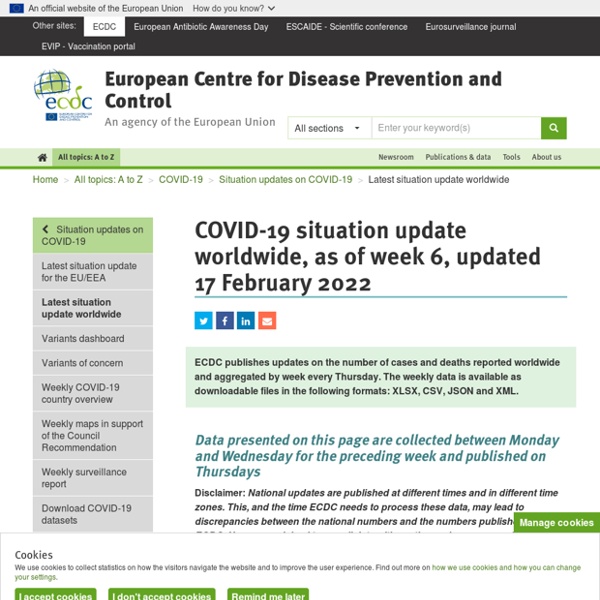Zoom
Trash



https://www.ecdc.europa.eu/en/geographical-distribution-2019-ncov-cases
Related: Coronavirus • COVID-19 • Coronavirus • Covid-19 ☣️Coronavirus COVID-19 (2019-nCoV) Lancet Inf Dis Article: Here. Mobile Version: Here. Data sources: Full list. Downloadable database: GitHub, Feature Layer. Lead by JHU CSSE. Technical Support: Esri Living Atlas team and JHU APL. Daily risk assessment on COVID-19, 1 March 2020 As countries regained control of transmission and alleviated the burden on healthcare, many measures were relaxed or removed to allow for a more viable way of life with the virus in circulation. Subsequently, a recent increase in COVID-19 cases has been reported in many EU/EEA countries. What is the risk of further escalation of COVID-19 in the countries that have reported a recent increase in COVID-19 cases, as of 10 August 2020? In EU/EEA countries and the UK where a recent increase in cases has been reported:
Map tracks coronavirus outbreak in near real time By Doug Donovan /Published Jan 23 The Johns Hopkins Center for Systems Science and Engineering has built and is regularly updating an online dashboard for tracking the worldwide spread of the coronavirus outbreak that began in the Chinese city of Wuhan. esri As hundreds of millions of eyes stay glued to the rising toll and reach of the novel coronavirus disease 2019 (COVID-19), map-based dashboards have become a compelling, near real-time way to monitor the outbreak. They’ve also substantiated the message that everyone must take precautions and alter daily interactions. When the World Health Organization (WHO) declared COVID-19 a pandemic, director-general Tedros Adhanom Ghebreyesus warned that the situation would worsen. Yet, he noted, this is the first world pandemic that can be controlled, in part due to global connectivity and awareness. The controllability of COVID-19 can also be attributed to tools that quantify data inputs—and aggregate information about who and when in the context of where.
Coronavirus: Is the pandemic getting worse in the US? The news in the US has been dominated by anti-racism protests for the past couple of weeks, but coronavirus is now back in the headlines. Several states have seen a record number of cases in recent days, leading to fears that the country is experiencing a second wave of infections. But Vice-President Mike Pence said those fears were "overblown" and accused the media of using "grim predictions" to scare the American people.
Number of coronavirus (COVID-19) cases and risk in the UK Video: How to wash your hands properly Number of cases and deaths As of 9am on 27 April, there have been 719,910 tests, with 37,024 tests on 26 April. Coronavirus: The lost six weeks when US failed to contain outbreak News BBC News Navigation Sections Previous Next Media player Media playback is unsupported on your device Coronavirus latest: WHO describes outbreak as pandemic We are no longer updating this page. Find Nature’s latest coronavirus coverage here. Read highlights from the coronavirus research literature here. 22 April 17:05 bst — Deaths suggest the coronavirus was in the United States weeks earlier than thought
Coronavirus Update (Live): 3,567,005 Cases and 248,313 Deaths from COVID-19 Virus Pandemic - Worldometer How dangerous is the virus? There are three parameters to understand in order to assess the magnitude of the risk posed by this novel coronavirus: Transmission Rate (Ro) - number of newly infected people from a single caseCase Fatality Rate (CFR) - percent of cases that result in death Determine whether asymptomatic transmission is possible
Mobility network models of COVID-19 explain inequities and inform reopening The Methods is structured as follows. We describe the datasets that we used in the ‘Datasets’ section and the mobility network that we derived from these datasets in the ‘Mobility network’ section. In the ‘Model dynamics’ section, we discuss the SEIR model that we overlaid on the mobility network; in the ‘Model calibration’ section, we describe how we calibrated this model and quantified uncertainty in its predictions.
COVID-19 At the end of December 2019, Chinese public health authorities reported several cases of acute respiratory syndrome in Wuhan City, Hubei province, China. Chinese scientists soon identified a novel coronavirus as the main causative agent. The disease is now referred to as coronavirus disease 2019 (COVID-19), and the causative virus is called severe acute respiratory syndrome coronavirus 2 (SARS-CoV-2). It is a new strain of coronavirus that has not been previously identified in humans. The initial outbreak in Wuhan spread rapidly, affecting other parts of China. Cases were soon detected in several other countries.
How coronavirus spread across the globe - visualised Since New Year’s Eve the world has lived through 100 days of Covid-19. There have been over 1.3m confirmed cases, and over 75,000 deaths. Billions of people are confined to their homes and stock markets have plummeted. Here is how the crisis unfolded. Launch and Scale Speedometer Mapping COVID-19 Vaccine Pre-Purchases Across the Globe A flurry of nearly 200 COVID-19 vaccine candidates are moving forward through the development and clinical trials processes at unprecedented speed; more than ten candidates are already in Phase 3 large-scale trials and several have received emergency or limited authorization. Also unprecedented is the number of advance market commitments (AMCs) made by countries and multilateral partnerships eager to reserve vaccine supply, even before any candidates are on the market. Our team has aggregated and analyzed publicly available data on vaccine procurement and manufacturing to track the flow of procurement and better understand global equity challenges.